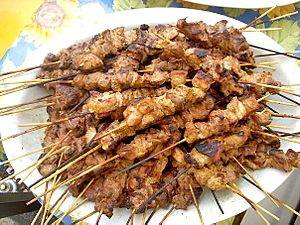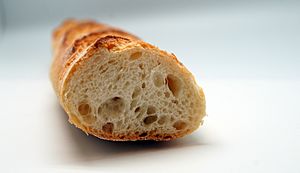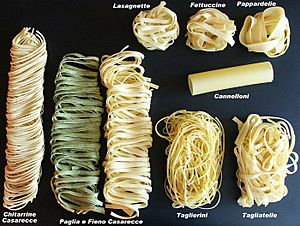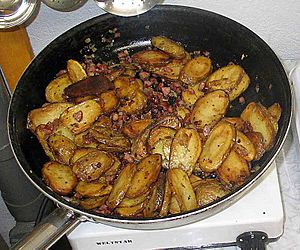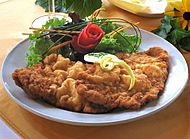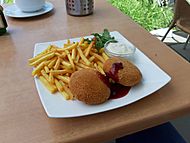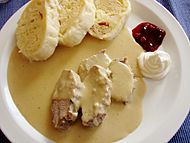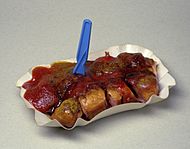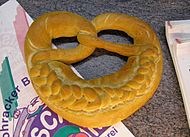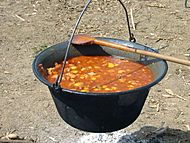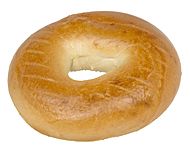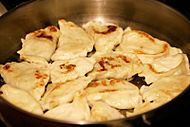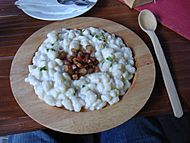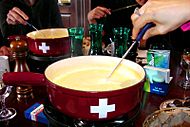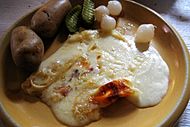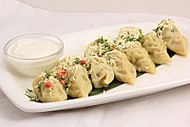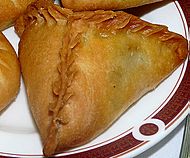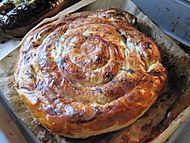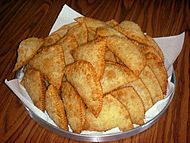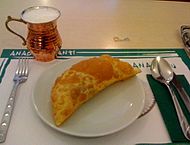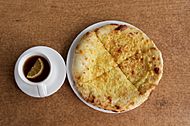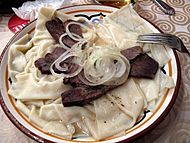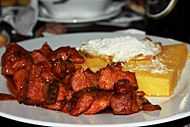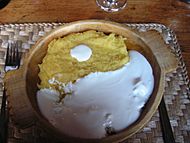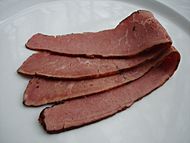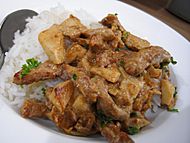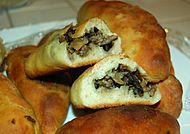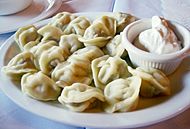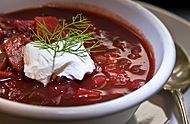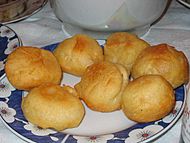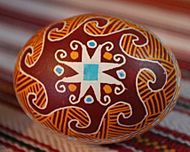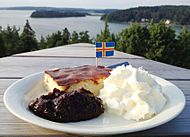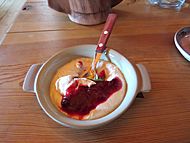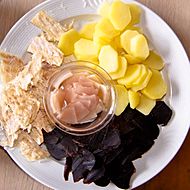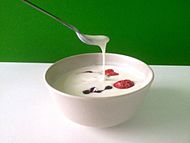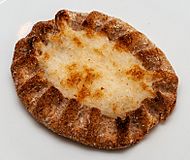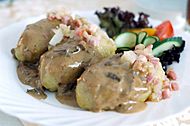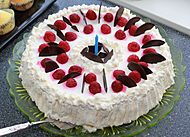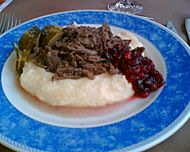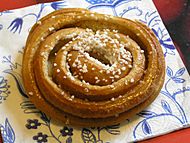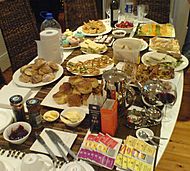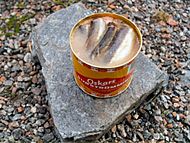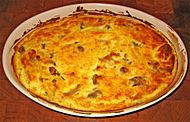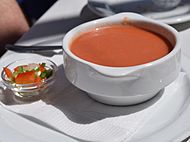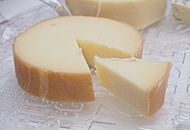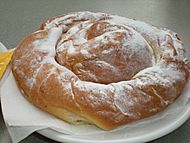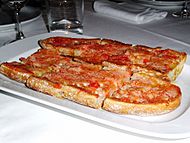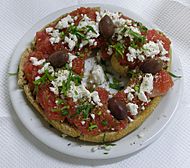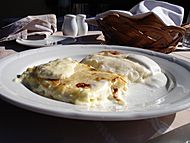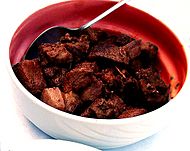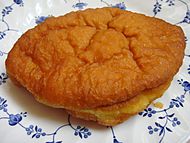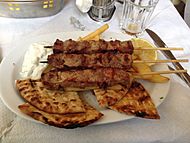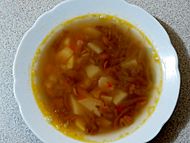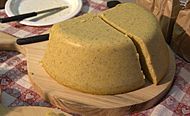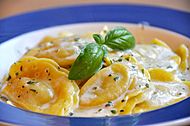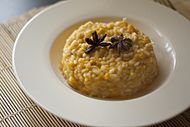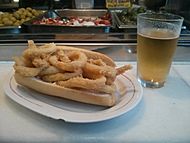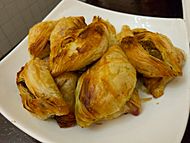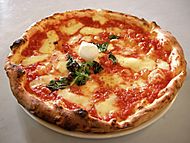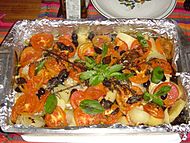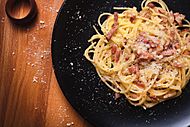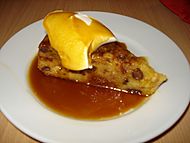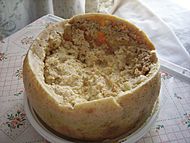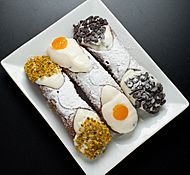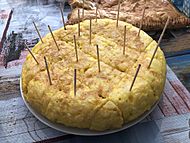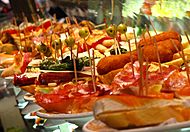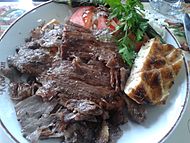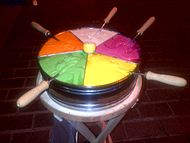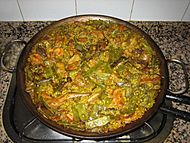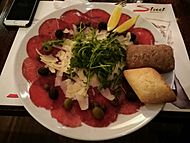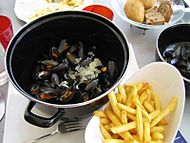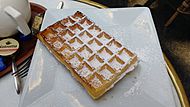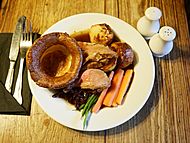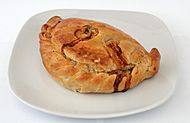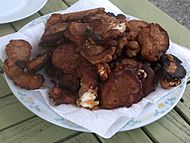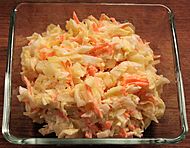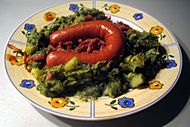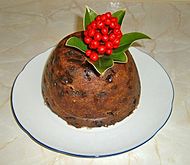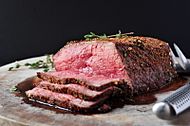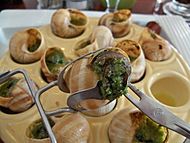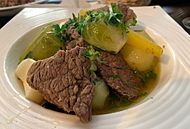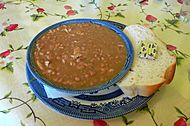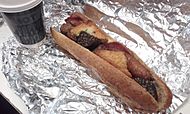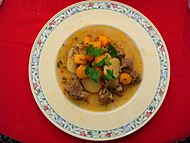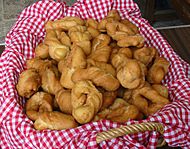European cuisine facts for kids
European cuisine includes all the different ways of cooking and eating from countries across Europe. It also covers the foods brought to other parts of the world by European explorers and settlers. Sometimes, when people say "European cuisine," they mean the food from the western parts of mainland Europe.
Even though Western countries have many different foods, they share some common features. For example, meat is often a main part of the meal, and servings can be quite large. Dishes like steak and cutlets are common.
European cooking often uses grape wine and different sauces. These sauces can be used for flavor, seasoning, or as a side. Many dairy products are also used, like the hundreds of types of cheese and other fermented milk foods.
For a long time, white wheat-flour bread was seen as fancy. But in the past, most people ate bread, flatcakes, or porridge made from grains like rye, spelt, barley, and oats. Wealthier people also enjoyed pasta, dumplings, and pastries.
After Europeans explored the Americas, the potato became a very important food in Europe. Maize (corn) is not as common in most European diets as it is in the Americas. However, cornmeal, like polenta or mămăligă, is a big part of the food in Italy and the Balkans.
While flatbreads (like pizza) and rice are eaten in Europe, they are only main foods in a few areas, mostly in Southern Europe. Salads, which are cold dishes with raw or cooked vegetables and sometimes a dressing, are also a key part of European meals.
Contents
How European Meals Are Served
Formal European dinners are usually served in separate parts, called courses. In the past, all dishes were brought to the table at once. Now, dishes are served one after another.
Usually, cold foods, then hot and savory foods, and finally sweet foods are served in this order. This means you might start with an appetizer or soup, then have the main dish, and finish with dessert. In ancient times, sweet and savory dishes were mixed, but today, sweet foods are only for dessert.
When guests can serve themselves food, it's called a buffet. Buffets are often for parties or holidays. Even at a buffet, people usually follow the same order of courses.
Historically, European cooking was developed in royal and noble courts. Noble people often lived in country homes and carried knives. So, eating steaks and other foods that needed cutting was common. This was different from East Asia, where court officials had food prepared to eat with chopsticks.
Later, the spoon was used for soups, and the fork became common around the 16th century. Today, most European dishes are eaten with cutlery (knives, forks, spoons). Only a few finger foods are eaten with hands in polite company.
History of European Cuisine
Medieval Times: Food for Everyone
In the Middle Ages, what a person ate depended a lot on their social class. Grains were a huge part of everyone's diet. Bread was common for both rich and poor. Working people ate bread for lunch, and thick slices of it were even used as plates, called "trenchers."
Noble people had access to very fine flours for their breads and baked goods. They could also hunt animals like deer, boar, rabbits, and birds, giving them fresh meat and fish. Their dishes often had many spices. Spices were very expensive back then, so using a lot of them showed how wealthy a person was. Common spices included cinnamon, ginger, nutmeg, pepper, cumin, cloves, turmeric, anise, and saffron.
Other expensive ingredients for nobles included sugar, almonds, and dried fruits like raisins. These imported items were almost impossible for common people to get. When banquets were held, the food was amazing. Sugar sculptures decorated tables, and foods were dyed bright colors with costly spices to show off wealth.
Commoners' Simple Meals
The food for common people was much simpler. Strict laws prevented them from hunting, and if they were caught, they could be killed. Much of their food was preserved, like by pickling or salting. Their breads were made from rye or barley. Any vegetables they ate were likely grown by themselves.
Peasants could often keep cows, so they had milk to make butter or cheese. When they ate meat, it was usually beef, pork, or lamb. Commoners also ate a dish called pottage, which was a thick stew of vegetables, grains, and sometimes meat.
Early Modern Era: New Foods Arrive
In the Early modern period, European food changed a lot. New ingredients arrived from the Americas because of the Columbian Exchange. These included the potato, tomato, eggplant, chocolate, bell pepper, and different types of squash.
Drinks like distilled spirits, tea, coffee, and chocolate also became very popular during this time. In the 1780s, the idea of the modern restaurant began in Paris. The French Revolution helped restaurants grow quickly and spread across Europe.
Central European Cuisines
Each country in Central Europe has its own special dishes. Austria is famous for Wiener schnitzel, a breaded veal cutlet. The Czech Republic is known for its beers. Germany has world-famous wursts (sausages), and Hungary is known for goulash. Slovakia is famous for gnocchi-like Halusky pasta. Slovenia's food is influenced by German and Italian cooking. Poland is known for its pierogi, which are like a mix of ravioli and empanadas. Liechtenstein and German-speaking Switzerland are famous for Rösti, while French-speaking Switzerland is known for fondue and Raclettes.
- Ashkenazi Jewish cuisine
 Austrian cuisine
Austrian cuisine
 Czech cuisine
Czech cuisine
 German cuisine
German cuisine
 Hungarian cuisine
Hungarian cuisine Polish cuisine
Polish cuisine
 Liechtenstein cuisine
Liechtenstein cuisine Silesian cuisine
Silesian cuisine Slovak cuisine
Slovak cuisine Slovenian cuisine
Slovenian cuisine Swiss cuisine
Swiss cuisine
-
Austrian strudel
-
Austrian Wiener Schnitzel
-
Czech Smažený sýr
-
Czech Svíčková
-
German Currywurst
-
German pretzel
-
German Sauerbraten
-
Hungarian goulash
-
Polish bagel
-
Polish pierogi
-
Slovakian Bryndzové halušky
-
Slovenian Idrijski žlikrofi
-
Slovenian Prekmurska gibanica
-
Swiss fondue
-
Swiss raclette
Eastern European Cuisines
 Armenian cuisine
Armenian cuisine Azerbaijani cuisine
Azerbaijani cuisine Belarusian cuisine
Belarusian cuisine Bulgarian cuisine
Bulgarian cuisine Georgian cuisine
Georgian cuisine Kazakh cuisine
Kazakh cuisine Moldovan cuisine
Moldovan cuisine

 Ossetian cuisine
Ossetian cuisine Romanian cuisine
Romanian cuisine Russian cuisine
Russian cuisine
 Ukrainian cuisine
Ukrainian cuisine
-
Armenian khorovats
-
Azerbaijani Gürzə
-
Bashkir and Tatar Öçpoçmaq
-
Belarusian potato babka
-
Bulgarian banitsa
-
Circassian Haliva
-
Crimean Tatar chiburekki
-
Georgian khachapuri
-
Kazakh beshbarmak
-
Moldovan Tochitură
-
Romanian mămăligă
-
Romanian pastrami
-
Russian beef Stroganoff
-
Russian pirozhki
-
Russian pelmeni
-
Ukrainian borscht
-
Ukrainian pampushka
Northern European Cuisines
 Danish cuisine
Danish cuisine
 Estonian cuisine
Estonian cuisine Finnish cuisine
Finnish cuisine Icelandic cuisine
Icelandic cuisine Latvian cuisine
Latvian cuisine Lithuanian cuisine
Lithuanian cuisine Livonian cuisine
Livonian cuisine Norwegian cuisine
Norwegian cuisine Sami cuisine
Sami cuisine Swedish cuisine
Swedish cuisine
-
Danish smørrebrød
-
Estonian kama dessert
-
Faroese tvøst og spik
-
Finnish viili
-
Icelandic hákarl
-
Latvian layered rye bread
-
Lithuanian cepelinai
-
Norwegian bløtkake
-
Norwegian fårikål
-
Sami Sautéed reindeer
-
Swedish cinnamon roll
-
Swedish smörgåsbord
-
Swedish surströmming
Southern European Cuisines
 Albanian cuisine
Albanian cuisine
 Aromanian cuisine
Aromanian cuisine Bosnian cuisine
Bosnian cuisine Croatian cuisine
Croatian cuisine Cypriot cuisine
Cypriot cuisine Gibraltarian cuisine
Gibraltarian cuisine Greek cuisine
Greek cuisine
 Italian cuisine
Italian cuisine
 Macedonian cuisine
Macedonian cuisine Maltese cuisine
Maltese cuisine Montenegrin cuisine
Montenegrin cuisine Ottoman cuisine
Ottoman cuisine Portuguese cuisine
Portuguese cuisine Sammarinese cuisine
Sammarinese cuisine- Sephardic Jewish cuisine
 Serbian cuisine
Serbian cuisine Spanish cuisine
Spanish cuisine
 Turkish cuisine
Turkish cuisine
-
Albanian Tavë kosi
-
Andalusian gazpacho
-
Aromanian Metsovone
-
Balearic ensaïmada
-
Basque talo
-
Bosnian ćevapi
-
Canarian Papas arrugadas
-
Catalan pa amb tomàquet
-
Cretan Dakos
-
Croatian Zagorski štrukli
-
Cypriot Afelia
-
Greek gyros
-
Greek spanakopita
-
Greek souvlaki
-
Italian gelato
-
Italian polenta
-
Italian ravioli
-
Lombard risotto
-
Macedonian Tavče gravče
-
Madrilenian squid sandwich
-
Maltese pastizz
-
Montenegrin njeguški pršut
-
Neapolitan pizza
-
Portuguese bacalhau
-
Portuguese Cozido à portuguesa
-
Roman carbonara
-
Sammarinese Bustrengo
-
Sardinian casu martzu
-
Serbian Pljeskavica
-
Sicilian cannoli
-
Spanish churro
-
Spanish tapas
-
Turkish doner kebab
-
Turkish macun
-
Valencian paella
-
Venetian carpaccio
Western European Cuisines
 Belgian cuisine
Belgian cuisine British cuisine
British cuisine
 Dutch cuisine
Dutch cuisine French cuisine
French cuisine
 Irish cuisine
Irish cuisine Luxembourgian cuisine
Luxembourgian cuisine- Mennonite cuisine
 Monégasque cuisine
Monégasque cuisine Occitan cuisine
Occitan cuisine
-
Belgian moules-frites
-
Belgian waffle
-
British bangers and mash
-
British full breakfast
-
British Sunday roast
-
Cornish pasty
-
Corsican fritelli
-
Dutch coleslaw
-
English Christmas pudding
-
English fish and chips
-
English roast beef
-
French escargot
-
French pot-au-feu
-
French quiche
-
Irish breakfast roll
-
Luxembourgian Judd mat Gaardebounen
-
Monégasque Barbajuan
-
Northern Irish pastie supper
-
Occitan aligot
-
Scottish haggis
-
Scottish Scotch pie
-
Welsh crumpet
See also
 In Spanish: Gastronomía de Europa para niños
In Spanish: Gastronomía de Europa para niños


